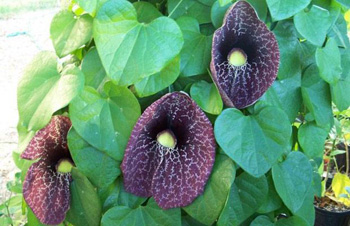Contents:
Common Names | Parts Usually Used | Plant(s) & Culture | Where Found | Medicinal Properties
Uses | Formulas or Dosages | Warning | Bibliography
Scientific Names

- Aristolochia clematitis L.
- Aristolochiaceae
- Birthwort family
Common Names
- Aristolochia root
- Ma-tou-ling
- Upright birthwort
Parts Usually Used
Rootstock, flowers
Back to Top
Description of Plant(s) and Culture
Birthwort is a perennial plant; the erect, yellow-green, somewhat sinuous stem grows
Other varieties: Virginia snakeroot
Back to Top
Where Found
Found growing in fence rows, tickets, field edges, and vineyards.
Back to Top
Medicinal Properties
Diaphoretic, emmenagogue, febrifuge, oxytocic, stimulant
Back to Top
Uses
The ancient Egyptians used birthwort for snakebite. Used for uterine contractions in childbirth, indigestion, dysmenorrhea, menstrual problems. The decoction used externally for wounds, sores, and leg ulcers.
Back to Top
Formulas or Dosages
Use the entire plant when it is in flower, otherwise use only the rootstock.
Decoction: use
Cold extract: Use
Back to Top
Warning
Birthwort contains a substance that acts similar to poisonous alkaloid colchicine. Use with care, preferably with medical supervision.
Do not take during pregnancy, only during labor at childbirth.
Use only under medical supervision.
Back to Top
Bibliography
![]() Culpeper’s Complete Herbal & English Physician: Updated With 117 Modern Herbs
Culpeper’s Complete Herbal & English Physician: Updated With 117 Modern Herbs, by Nicholas Culpeper, Meyerbooks, publisher, PO Box 427, Glenwood, Illinois 60425, 1990, (reprint of 1814)
![]() Eastern/Central Medicinal Plants
Eastern/Central Medicinal Plants, by Steven Foster and James A. Duke., Houghton Mifflin Company, 215 Park Avenue South, New York, NY 10000
![]() The Herb Book
The Herb Book, by John Lust, Bantam Books, 666 Fifth Avenue, New York, NY. copyright 1974.
![]() Chinese Medicinal Herbs
Chinese Medicinal Herbs, compiled by Shih-Chen Li, Georgetown Press, San Francisco, California, 1973.
![]() Indian Herbalogy of North America
Indian Herbalogy of North America, by Alma R. Hutchens, Shambala Publications, Inc., Horticultural Hall, 300 Massachusetts Avenue, Boston, Massachusetts 02115, 1973
![]() Webster’s New World Dictionary
Webster’s New World Dictionary, Third College Edition, Victoria Neufeldt, Editor in Chief, New World Dictionaries: A Division of Simon & Schuster, Inc., 15 Columbus Circle, New York, NY 10023
 The Rodale Herb Book: How to Use, Grow, and Buy Nature’s Miracle Plants (An Organic gardening and farming book)
The Rodale Herb Book: How to Use, Grow, and Buy Nature’s Miracle Plants (An Organic gardening and farming book), edited by William H. Hylton, Rodale Press, Inc. Emmaus, PA, 18049., 1974
